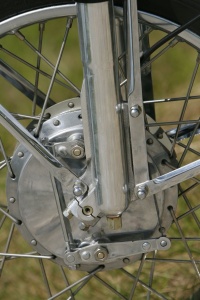
McDEEB Trackster RE500


Royal Enfield Cafe Racer by T-Factor Bikes
T-Factor Bikes specializes in Royal Enfield, Norton and Benelli. They sell and maintain bikes but what they are most passionate about is customizing and rebuilding bikes at the demand of their customers. All three contribute to the projects and the end result represents a little piece of each of them.Whilst they were busy on another bike project they came up with the idea to build a Royal Enfield Café Racer. They had the idea and they have done it, in roducing their Royal Enfield Cafe Racer. Powered By new Royal Enfield Bullet Electra 500EFI engine


 |
| 1965 Royal Enfield 250cc Turbo Twin Sports |
The Villiers 2T/4T proprietary engine enabled a host of manufacturers to offer a twin-cylinder two-stroke model in the all-important learner market during the 1960s, novice riders being restricted to machines under 250cc at the time. Royal Enfield’s offering used the later 4T engine, which featured a more angular top end incorporating cylinders with four transfer ports (the 2T had only two) and ported pistons. Otherwise the 4T remained much as its predecessor. Enfield fitted the Villiers twin into a Crusader frame, while the cycle parts were those of the Clipper model. Introduced in November 1963, the original Turbo Twin was replaced in 1964 by the Turbo Twin Sports, which featured a chromium plated fuel tank and mudguards. In this form the model remaining in production until late in 1966.
 |
| 1965 Royal Enfield 250cc Turbo Twin Sports |
 |
| 1965 Royal Enfield 250cc Turbo Twin Sports |
 |
| 1965 Royal Enfield 250cc Turbo Twin Sports |
 |
| 1965 Royal Enfield 250cc Turbo Twin Sports |

 |
| 1965 Royal Enfield GP5 250cc |
Geoff Duke was hired as project consultant and Reynolds’ Ken Sprayson came up with a neat duplex loop frame, but the prototype was let down by the poor performance of its – at that time – under-developed Villiers Starmaker engine. Seeking a solution, Enfield turned to two-stroke guru Hermann Meier, who had prepared the Ariel Arrow ridden to a sensational 7th place in the 1960 Lightweight TT by Mike O’Rourke. Rather than being given the free hand he expected, Meier was told to keep costs down and use products from within the E H P Smith Group, Enfield’s owners.
 |
| 1965 Royal Enfield GP5 250cc |
 |
| 1965 Royal Enfield GP5 250cc |
Thus the GP5 had an Alpha crankcase assembly, Albion gearbox and a clutch based on that of Enfield’s roadster twins. Using a Meier-designed cylinder with four, rather than the conventional two, transfer ports, the GP5 engine produced respectable power – around 36bhp, which was more than the contemporary Silverstone – yet results on the race track were disappointing to say the least. Only on one occasion did the bike show its true potential, when Percy Tait finished 3rd behind the works Yamahas of Phil Read and Mike Duff in the 1965 Hutchinson 100 at Silverstone.
 |
| 1965 Royal Enfield GP5 250cc |
 |
| 1965 Royal Enfield GP5 250cc |

Assembly of R.E. Bullets began in India in 1955 from parts sources from Britain, and by 1962 the bikes were being manufactured by Enfield of India, which purchased the rights to the Royal Enfield name in 1995 and is now known as Royal Enfield of India.
Postwar Model G and Model J and ex-military C and CO (1946–1954)
Postwar, Royal Enfield resumed production of the single cylinder ohv 350cc model G and 500cc Model J, with rigid rear frame and telescopic front forks. These were ride-to-work basic models, in a world hungry for transport. A large number of factory reconditioned ex-military sv Model C and ohv Model CO singles were also offered for sale, as they were sold off as surplus by various military services.
Spring frame Bullets 350cc 1949-1970
In 1948, a groundbreaking development in the form of rear suspension springing was developed, initially for competition model “trials” models (modern enduro type machines), but this was soon offered on the roadgoing Model Bullet 350cc, a single cylinder ohv. This was a very popular seller, offering a comfortable ride. A 500cc version appeared shortly after. A later 1950s version of the Bullet manufacturing rights and jigs, dies and tools was sold to India for manufacture there, and where developed versions continue to this day.
So here is screenshots and renders.
i hope u like 






















 A café racer is a type of motorcycle as well as a type of motorcyclist. Both meanings have their roots in the 1960s British counterculture group the Rockers, or the Ton-up boys, although they were also common in Italy, Germany, and other European countries. In Italy, the term refers to the specific motorcycles that were and are used for short, sharp speed trips from one coffee bar to another.[1]
A café racer is a type of motorcycle as well as a type of motorcyclist. Both meanings have their roots in the 1960s British counterculture group the Rockers, or the Ton-up boys, although they were also common in Italy, Germany, and other European countries. In Italy, the term refers to the specific motorcycles that were and are used for short, sharp speed trips from one coffee bar to another.[1]A classic example of this was to race from the Ace Cafe on the North Circular Road in northwest London to the Hanger Lanejunction as it then was—it is now the more famous Hanger Lane gyratory—and back again. The aim was to get back to the Ace Cafe before the record on the jukebox had finished. Given that some of the Eddie Cochran tunes that were in vogue at this time were less than two minutes long, the racers had to make the three-mile round trip at extremely high speed.